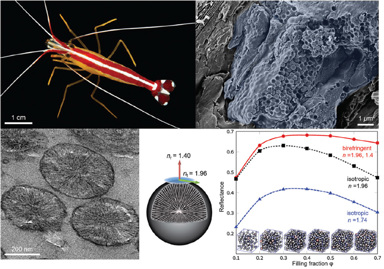 [Enlarge image]Brilliant whiteness in Pacific cleaner shrimp (top left) is generated from dense arrays of nanospheres (top right) comprising one-dimensionally ordered, spherulitic assemblies of isoxanthopterin (bottom left) which results in extreme birefringence (bottom center). Birefringence enhances scattering efficiency and reduces optical crowding at high densities (bottom right). [Shrimp image: J. Sartore / Photo Ark]
[Enlarge image]Brilliant whiteness in Pacific cleaner shrimp (top left) is generated from dense arrays of nanospheres (top right) comprising one-dimensionally ordered, spherulitic assemblies of isoxanthopterin (bottom left) which results in extreme birefringence (bottom center). Birefringence enhances scattering efficiency and reduces optical crowding at high densities (bottom right). [Shrimp image: J. Sartore / Photo Ark]
White coloration is produced by diffuse light propagation in disordered media, where multiple scattering occurs and directional information is lost, producing broadband, angle-independent backscattering. This is typically realized by introducing high-refractive-index scatterers within a low-refractive-index matrix. Although whiteness is simple to obtain in thick samples containing a large refractive-index contrast with the medium, it is challenging to achieve in thin, dense systems. This challenge arises from the phenomenon of optical crowding, which causes scatterers packed with filling fractions higher than roughly 30% to have significantly reduced reflectance due to near-field coupling between scatterers.1 Our recent work2 on white coloration in shrimp revealed an unexpected answer to this optical conundrum—the use of extremely birefringent scatterers.
Ultra-thin whiteness in beetles3 and butterflies4 is produced using a matrix of air (n = 1) to attain a sufficient refractive-index contrast with the organic scatterers. Here, we studied the brilliant white colors of cleaner shrimp, produced by an intracellular photonic system within an aqueous matrix, which poses a greater challenge for obtaining a high index contrast.
The shrimp’s whiteness is produced by extremely thin cells (< 5 μm thick) containing dense arrays of nanospheres. The nanospheres are composed of the planar molecule isoxanthopterin, which is found in crystalline form in crustacean eyes.5 In the shrimp, the nanospheres contain a spherulitic liquid crystal arrangement of isoxanthopterin molecules, which are stacked in spokes projecting from the center of the spheres. This anisotropic molecular arrangement results in extremely birefringent nanospheres with a tangential refractive index of around 2.0 and a radial index of approximately 1.4. Counterintuitively, we found that scattering layers with nanoscale birefringence outperform those made of isotropic media, even if their refractive index equals the high index of the birefringent structure. Numerical simulations showed that the polarization-averaged near-field coupling between a pair of birefringent spherulites is substantially lower compared with isotropic spheres.
Birefringence thus reduces optical crowding and allows efficient scattering up to the maximal packing of randomly arranged spheres, which decreases the thickness of material required for brilliant whiteness. Our work shows that extreme birefringence associated with molecular crystals and liquid crystals can be used as a design parameter in optical devices. We believe it could provide inspiration for designing organic optical materials as replacements for artificial scatterers like TiO2.
Researchers
Tali Lemcoff and Benjamin A. Palmer, Ben-Gurion University of the Negev, Beer-Sheva, Israel
Dan Oron, Weizmann Institute of Science, Rehovot, Israel
References
1. R.J. Bruehlman et al. Official Digest 33, 252267 (1961).
2. T. Lemcoff et al. Nat. Photon. 17, 485 (2023).
3. P. Vukusic et al. Science 315, 348 (2007).
4. D.G. Stavenga et al. Proc. R. Soc. Ser. B Biol. Sci. 271, 1577 (2004).
5. B.A. Palmer et al. Nat Nanotechnol. 15, 138 (2020).
